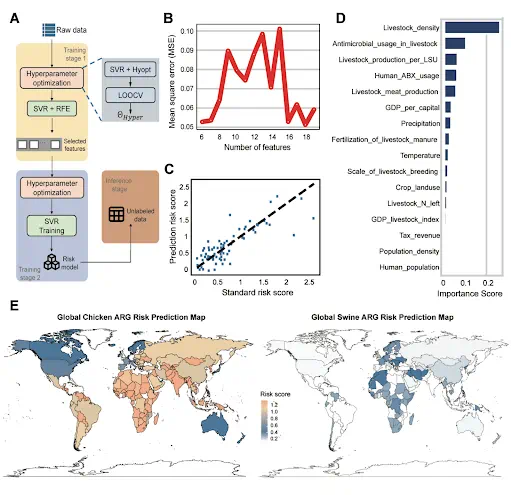A major international study by Michigan State University and partner researchers has uncovered a hidden danger lurking in animal farms around the world: Livestock manure is packed with antibiotic resistance genes that could threaten human health.
This study spanned 14 years and represents the most comprehensive survey of livestock antibiotic resistant genes to date. The research team examined over 4,000 manure samples from pigs, chickens and cattle in 26 countries.
“This research shows that what happens on farms doesn’t stay on farms,” said James Tiedje, a world-renowned expert in microbiology at MSU and one of the authors of the study. “Genes from manure can make their way into the water we drink, the food we eat and the bacteria that make us sick.”
“Some antibiotic resistance genes are now widely known to be in DNA in soil, water and manures, but are they ones that are really risky?” said Tiedje, a University Distinguished Professor in the MSU Department of Microbiology, Genetics and Immunologyand the Department of Plant, Soil and Microbial Sciences. “But we took this a step further to determine whether those genes can become mobile and move into harmful bacteria, ones that have bad health outcomes. That’s what makes them a real risk.”
According to Xun “Shawn” Qian, professor at Northwest Agriculture and Forestry University in Yangling, China, and one of the study’s authors, livestock manure may act as an important environment for detecting the early signs of antibiotic resistance gene proliferation, offering public health systems a crucial opportunity for timely intervention.
“Our findings highlight the need for targeted monitoring and risk management of antibiotic resistance in major livestock-producing countries,”hesaid. “For instance, as the world’s leading beef producer, the United States shows significantly higher abundance and diversity of antibiotic resistance genes in cattle manure compared to other countries. Likewise, China, which is the world’s largest pig producer, exhibits elevated levels of bacterial abundance, diversity and overall resistance risk in swine manure, surpassing all other nations in our analysis.”
About antimicrobial resistance
Antimicrobial resistance occurs when antibiotics are overused, making genes resistant and treating infections more difficult. According to the World Health Organization, antimicrobial resistance is an urgent global public health threat, killing at least 1.27 million people worldwide and associated with nearly 5 million deaths in 2019.
In the United States, more than 2.8 million antimicrobial resistant infections occur each year. More than 35,000 people die as a result, according to the Centers for Disease Control and Prevention’s 2019 Antibiotic Resistance Threats Report.
“Antibiotic resistance isn’t just a medical issue, it’s an environmental one, too,” Tiedje said. “And it may pose an even greater risk than other pollutants because if these genes end up in harmful bacterium, they can directly cause deadly infections.”
At the same time, the study recognizes that antibiotics still play a critical role in protecting animal health when used properly.

Fig. 6 A predictive global map of resistome risk scores in livestock manure. (A) A schematic overview of machine learning used to predict risk scores of global livestock resistomes. (B) Mean square error (MSE) assessments. (C) Correlation between predictive and true risk scores. (D) Top 16 factors used to predict risk scores in livestock resistomes. The full name of each factor can be found in Supplementary Data. (E) A predictive map of risk scores in global chicken and swine resistomes in 2022. The color scale represents absolute risk score. Countries filled with white color were excluded from the risk prediction because of no livestock production.
“We need antibiotics to control disease,” Tiedje added. “That’s why it’s so important to protect their effectiveness. If resistance spreads too far, these life-saving drugs won’t work when we really need them.”
Encouragingly, the study found signs that efforts to reduce farm antibiotic use are paying off.
“There’s been a global push to reduce antibiotics in agriculture,” said Tiedje. “Denmark and other European countries led the way by banning growth-promotion antibiotics years ago and they’ve seen lower resistance levels as a result.”
The U.S. followed with its Veterinary Feed Directive in 2017, and China introduced similar restrictions shortly after. In all three places, there has been a decline in resistance genes in livestock manure over time. That shows that these policies work. But there is still much to be done, Tiedje said.
“The problem is so severe that governments worldwide are being asked by the United Nations to develop national action plans to tackle antibiotic resistance,” Tiedje said. “The data from this study can help countries decide what’s most important for them to act on and where those efforts can have the biggest impact.”
This work gives us a roadmap, Qian said. “By identifying the riskiest genes and the countries where they’re most likely to spread, we can start to better target surveillance and policy. Reducing risky antibiotic use on farms could make a real difference.”
And in today’s globalized world, the risks don’t stay contained within borders, Tiedje said.
“A resistant pathogen is only a plane flight away from anywhere,” he said. “By understanding and managing livestock antibiotic resistance, we help protect the effectiveness of antibiotics for everyone.”
The paper is published in the journal Science Advances.















